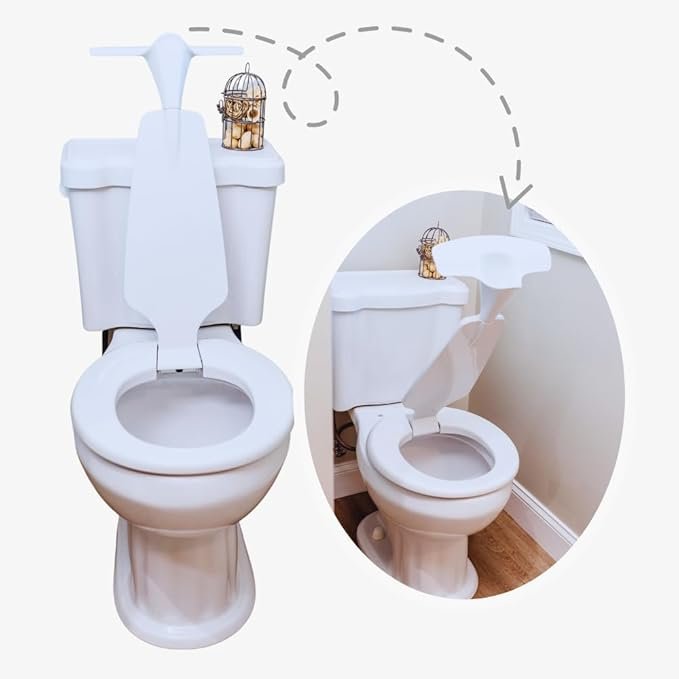From office buildings to schools and small businesses, facility managers are constantly looking for ways to make restrooms cleaner, more efficient, and easier to maintain. In men’s restrooms, one common issue is keeping things sanitary while managing limited space and reducing costs.
A practical solution gaining popularity? Urinal attachments for toilet. These innovative devices offer a cleaner, more space-efficient alternative to traditional urinals—without the need for costly plumbing renovations. Let’s explore why more facilities are making the switch and how this simple upgrade is transforming restroom design.
What Is a Urinal Attachment for a Toilet?
A urinal attachment is a specially designed fixture that fits onto a standard toilet, effectively converting it into a dual-purpose unit. Instead of installing a separate wall-mounted urinal, this attachment channels urine into the toilet bowl in a controlled, splash-resistant way.
The result? A more hygienic option that reduces mess, saves water, and requires far less infrastructure than traditional solutions.
Why Facilities Are Making the Switch
1. Improved Hygiene
Cleanliness is a top concern in public and commercial restrooms. Urinal attachments help reduce splashback and floor spills—two of the most common issues with traditional male restroom use.
Because these attachments guide the urine flow directly into the toilet bowl, they limit the need for lifting seats and reduce contact points, which leads to:
- Fewer unpleasant odors
- Lower risk of bacterial spread
- Easier cleaning for maintenance staff
2. Water and Cost Efficiency
Standard urinals and toilets often use more water than necessary—especially in older models. Many urinal attachments are designed to work with low-flow or dual-flush systems, which means:
- Less water per use
- Lower monthly water bills
- More sustainable operations overall
Some facilities have reported measurable water savings after switching to urinal attachments, especially in high-traffic areas.
3. Space Optimization
Not every restroom has room for a separate urinal and toilet. Urinal attachments eliminate the need for a separate fixture entirely, allowing facilities to:
- Maintain existing restroom layouts
- Serve more users in a smaller footprint
- Avoid costly structural or plumbing renovations
This is especially useful in smaller spaces like cafés, coworking offices, mobile facilities, or older buildings with limited plumbing access.
4. Easier Installation
Unlike traditional urinals that require new wall plumbing, urinal attachments fit onto existing toilets. This makes them:
- Affordable to implement
- Fast to install (often without a full renovation)
- Easy to replace or upgrade in the future
It’s a particularly attractive option for schools, daycares, or public institutions with limited budgets.
5. Better User Experience
A cleaner, more intuitive restroom experience improves user satisfaction—whether it’s employees, students, or customers. Men often prefer urinals for quick visits, and a well-designed toilet seat attachment can provide that same convenience without sacrificing hygiene or space.
Where Urinal Attachments Make the Most Sense
Urinal attachments can benefit nearly any shared restroom, but they’re especially useful in:
- Educational Facilities: Schools and universities looking to modernize without overhauling plumbing.
- Office Buildings: Improve hygiene while minimizing restroom congestion.
- Restaurants & Cafés: Make the most of compact spaces.
- Retail Stores: Offer quick, clean restroom access to staff and customers.
- Event Spaces: Accommodate more users without major layout changes.
What to Consider Before Installing
Before choosing a urinal attachment, facilities should keep the following in mind:
- Toilet Compatibility: Check that your existing toilets can support the model you choose.
- Drainage Design: Look for attachments with splash guards or curved channels for better flow.
- Cleaning & Maintenance: Choose designs that are easy to detach or clean.
- Regulatory Compliance: Ensure the setup meets ADA or local plumbing codes if applicable.
- Material Quality: Opt for durable, stain-resistant materials like ABS plastic or stainless steel.
- Expert product recommendations
- Guidance on fitting urinal attachments to your existing toilets
- Solutions designed for high-traffic, eco-conscious environments
- Support with sourcing and long-term planning
Our team works closely with businesses, schools, and property managers to improve hygiene, efficiency, and user experience—without breaking the budget.
Conclusion
In today’s world, clean and efficient restrooms are more than a nice-to-have—they’re a necessity. Urinal attachments for toilets offer an easy, affordable way to improve hygiene, reduce water use, and optimize space, especially in busy facilities.
